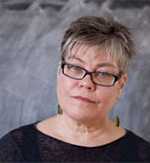Anne Innis Dagg in 1956, the year she became the first to record many giraffe behaviours in her notes. (Photo: Alexander Matthew)
I have tracked Innis Dagg to the archives at Ontario’s University of Waterloo, where her papers, and those of her famous mother, are stored. We are waiting for the archivist to bring out the African notebook that describes her very first observations of giraffes in the wild.
In the end, the farmer — whom she still refers to as Mr. Matthew all these years later — finally gave in and allowed her to study his giraffes. She was so determined, he said. And so far from home. He also said she could live in his farmhouse despite worries that it would appear unseemly because she was unmarried and his wife and daughters were away. She bought a hunch-backed little green Ford, drove two long days to his farm and began six months of 14-hour days watching giraffes. It was, she says, heaven.
She was finally with the wild giraffe, one of evolution’s most extravagant pranks. The tallest land animal, a giraffe has legs so long that it can step over most humans. Their towering necks are not rigid, but flexible enough to coil around the throat of a competitor with the ease of a boa constrictor. The male’s skull weighs three times that of the female — the better to use as a battering ram against opponents. Their mighty hearts tip the scales at nearly eight kilograms. Comical, knobby horns stick out on top of their heads and triangular ears often point parallel to the ground. Their tongues are deep purple, tethered to the back of the mouth with a band of delicate pink and capable of curling around a twig the way a New World monkey’s tail clasps a vine.
Giraffes are diffident. Despite sharing the African savannah with so many other creatures, giraffes don’t behave as though they are part of a community. “They do what they want and couldn’t care less what others think,” says Innis Dagg.
In 1956, when Innis Dagg began studying giraffes, so little was known about them or other African mammals that her pipesmoking colleague Rosalie (Griff) Ewer of Rhodes University used to screech to a halt when she saw roadkill and load it into her truck, rotted or not, so she could study the corpses. When it came to giraffes, no one formally trained in science had actually sat still and watched the same individuals for months on end, trying to figure out the basics: what they ate and when, who they mated with, how the herds were structured.
Innis Dagg broke all that ground, discovering among other things that giraffes eat day and night, that they are constantly on the move but not migratory, that males spend a lot of time sniffing and sipping females’ urine to see whether they are keen to mate and that males are fond of homosexual sex. All of it transformed the way science saw the creatures.
The archivist arrives with a trolley of material. Here is the first notebook from 1956, a faded blue Tudor scribbler, its cover boasting an image of St. George, that fabled preserver of princesses, mounted on his charge, slaying a dragon. (Privately, I wonder if the image is one of Innis Dagg’s dry jokes; surely no 1950s maiden was less in need of rescue.)
Innis Dagg has written “GOOD GIRAFFE NOTES 1” in the upper right corner. Inside, the lined, yellowed pages hold the research she had fought so hard and travelled so far to conduct, starting with her first full day of careful observations. She was euphoric that day, she says.
Thurs. Sept. 6. Sunny
9.00 Went to G. borehole. Saw 2
giraffes in C9 walking about,
about 200 yds. from troughs.
Male and female …
Today in the archives, more than six decades later, her eyes fill with tears with the shock of seeing her words again after such a long time. Being in Africa then was her golden age. She was young. She had a whole continent to explore. A whole life ahead of her. She was doing exactly what she wanted.
In the years since, she’s given birth to three children, outlived a husband and a subsequent partner, written more than 20 books and been stymied professionally. She earned her PhD at Waterloo in 1967 with the idea of becoming a professor and going off to Africa every summer to study the giraffe, as she might have done had she been born male.
But when it came time to find a permanent teaching job and tenure at any of the universities she applied to in southern Ontario, it was, again, no dice. Men got the jobs instead, even those who had not published as many papers. One science dean declared, in 1972, that he would never give tenure to a married woman. She made do with part-time work, scraping together money to continue publishing about the giraffe on the side. But in 1956 when she cracked open this notebook for the first time, all of this was yet to come.
“Things seemed so much easier then,” she says.









